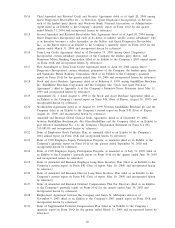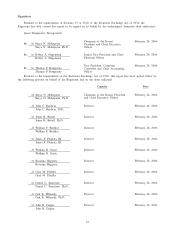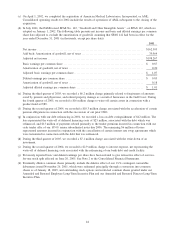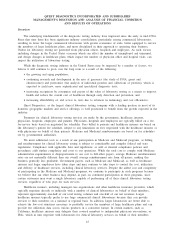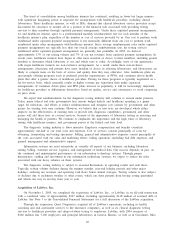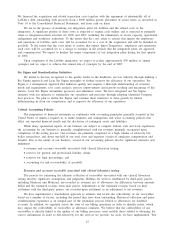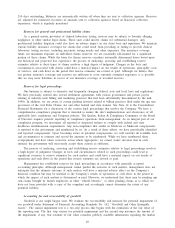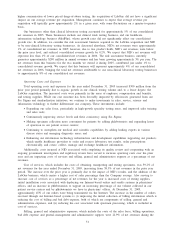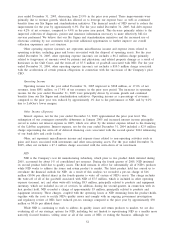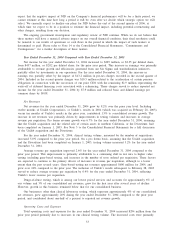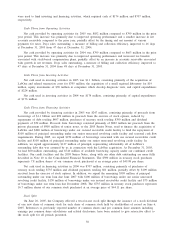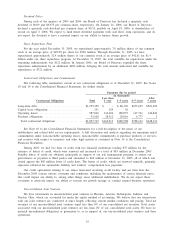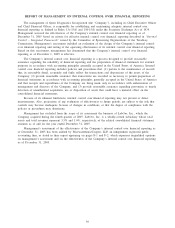Quest Diagnostics 2005 Annual Report Download - page 67
Download and view the complete annual report
Please find page 67 of the 2005 Quest Diagnostics annual report below. You can navigate through the pages in the report by either clicking on the pages listed below, or by using the keyword search tool below to find specific information within the annual report.capitalization of our Company, as well as (i) publicly available information regarding comparable publicly-traded
companies in the clinical laboratory testing industry, (ii) the financial projections and future prospects of our
business, including its growth opportunities and likely operational improvements, and (iii) comparable sales
prices, if available. As part of the first step to assess potential impairment, we compare our estimate of fair
value for the reporting unit to the book value of the reporting unit. If the book value is greater than our
estimate of fair value, we would then proceed to the second step to measure the impairment, if any. The second
step compares the implied fair value of goodwill with its carrying value. The implied fair value is determined
by allocating the fair value of the reporting unit to all of the assets and liabilities of that unit as if the
reporting unit had been acquired in a business combination and the fair value of the reporting unit was the
purchase price paid to acquire the reporting unit. The excess of the fair value of the reporting unit over the
amounts assigned to its assets and liabilities is the implied fair value of goodwill. If the carrying amount of the
reporting unit’s goodwill is greater than its implied fair value, an impairment loss will be recognized in the
amount of the excess. We believe our estimation methods are reasonable and reflect common valuation practices.
On a quarterly basis, we perform a review of our business to determine if events or changes in
circumstances have occurred which could have a material adverse effect on the fair value of the Company and
its goodwill. If such events or changes in circumstances were deemed to have occurred, we would perform an
impairment test of goodwill as of the end of the quarter, consistent with the annual impairment test performed
at the end of our fiscal year on December 31st, and record any noted impairment loss.
Results of Operations
Our clinical laboratory testing business currently represents our one reportable business segment. The
clinical laboratory testing business accounts for approximately 95% of consolidated net revenues in each of the
three years ended December 31, 2005. Our other operating segments include our non-clinical laboratory testing
businesses and consist of our risk assessment services business, our clinical trials testing business, our test kit
manufacturing subsidiary, NID, and our healthcare information technology business, MedPlus. Our business
segment information is disclosed in Note 15 to the Consolidated Financial Statements.
Year Ended December 31, 2005 Compared with Year Ended December 31, 2004
Net income for the year ended December 31, 2005 increased to $546 million, or $2.66 per diluted share,
compared to $499 million, or $2.35 per diluted share in 2004. The increase in earnings was primarily
attributable to organic revenue growth, and increases in operating efficiencies in our clinical testing business
resulting from our Six Sigma and standardization efforts, in addition to efficiencies resulting from increased use
of electronic ordering by physicians. Partially offsetting the increase was the performance at our test kit
manufacturing subsidiary, NID, which reduced consolidated revenue growth and earnings per share growth by
0.2% and $0.16 per share, respectively, compared to the prior year. The impact of NID and our plans for that
business are discussed in greater detail under NID.
Net Revenues
Net revenues for the year ended December 31, 2005 grew by 7.4% over the prior year level to
$5.5 billion. The acquisition of LabOne, which was completed on November 1, 2005, contributed 1.7% of the
consolidated revenue growth. Approximately 55% of LabOne’s net revenues are generated from risk assessment
services provided to life insurance companies, with the remainder classified as clinical laboratory testing.
Our clinical testing business, which accounted for over 95% of our 2005 consolidated net revenues, grew
approximately 7.0% for the year. The acquisition of LabOne contributed approximately 1% to the growth in
clinical laboratory testing net revenues, principally reflected in volume. The increase in clinical testing revenues
was driven by improvements in both testing volumes, measured by the number of requisitions, and increases in
average revenue per requisition.
For the year ended December 31, 2005, clinical testing volume increased 4.4% compared to the prior year
period.
For the year ended December 31, 2005, average revenue per requisition improved 2.3%. These
improvements are primarily attributable to a continuing shift in test mix to higher value testing, including gene-
based and esoteric testing, and increases in the number of tests ordered per requisition. Gene-based testing net
revenues were over $660 million for 2005, and grew approximately 10% compared to the prior year. Although
LabOne’s clinical testing business carries a lower revenue per requisition than our average, principally due to a
50


